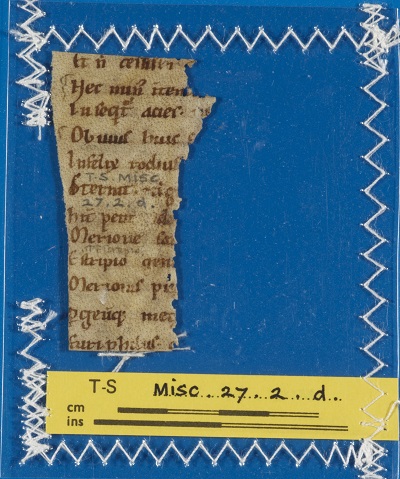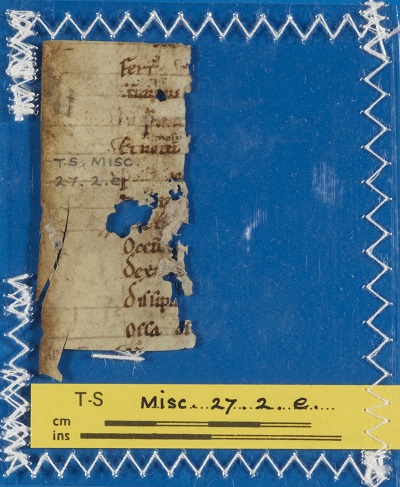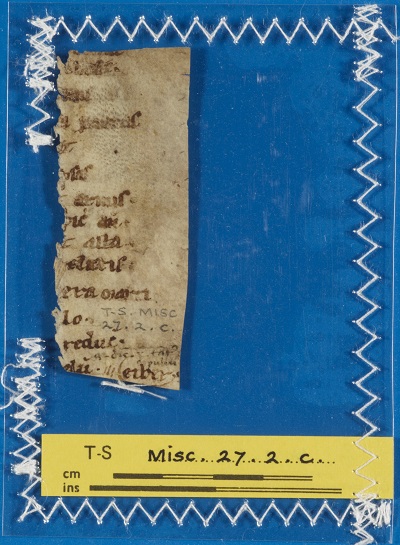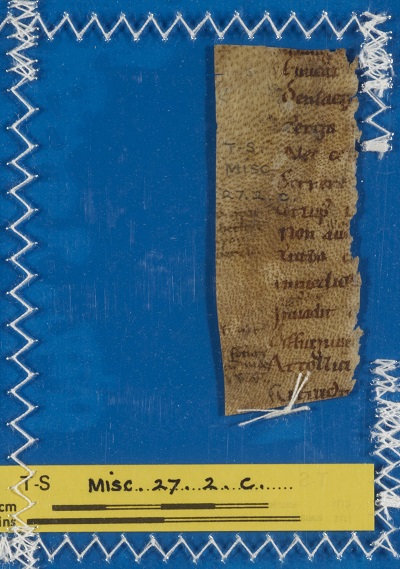The Latin Iliad in the Cairo Genizah (T-S Misc. 27.2 c-e)
Gideon Bohak and Serena Ammirati
The Cairo Genizah never ceases to surprise its devotees. Among its many fragments, the vast majority are written in Judaeo-Arabic, Hebrew, Aramaic and Arabic, all of which were widely known and used by the Jews of Cairo and their brethren in the Islamic world from the Middle Ages to the twentieth century. But there are also fragments in other languages, whose presence in the storeroom of a medieval synagogue is more puzzling. During my own efforts to systematically survey all Genizah fragments in the world in search of texts pertaining to magic, astrology, divination and alchemy, I ran into some eighty-five fragments written in Latin characters. Some of these I could identify as Spanish, others are written in Italian, but some of the fragments seemed to be written in medieval Latin scripts that I could not decipher. The breakthrough came last year, when I participated in a conference on the Qubbat al-Khazna, the “Genizah” of the Great Mosque in Damascus, which contained mostly Quranic manuscripts but also some fragments of Christian and Jewish texts. In that conference, several scholars discussed the Latin fragments found in the Damascus Genizah, and dating to the Crusader period, and it was then that I realized that some of the Latin fragments from the Cairo Genizah might belong in the same historical context. I then asked one of the participants, Dr. Serena Ammirati, to look at the Latin-script fragments from Cairo and see whether she could decipher their contents. She can already point to one successful identification, and quite an unexpected find, described by her as follows -
T-S Misc. 27.2c-e are three small scraps of parchment, written on both sides, bearing the same Latin script, and stemming from a single manuscript. The script is a Caroline minuscule, probably originating in North-East France in the eleventh or twelfth century.
All three fragments contain verses from a poem known as Ilias Latina, originally composed by Baebius Italicus in the age of Nero, in the mid-first century CE. This text, which is a Latin abbreviation (in ca. 1000 verses) of Homer’s Iliad, was extremely popular in the Middle Ages, especially in school.[1] Our fragments stem from the section that covers the fifth book of the Iliad, in which are recounted the great battles that took place between the Trojan and the Greek heroes before the walls of Troy, including the famous scene where Diomedes wounds the goddess Aphrodite, who hurries back to Mount Olympus to cry to her mother, Dione. Fragments 2d and 2e belong to the same original leaf: on the hair side, they preserve the beginnings and endings of lines 423-424; on flesh side, of lines 442-444. Fragment 2c has the endings of lines 461-475 on the hair side, and the beginnings of lines 482-495 on the flesh side.
The text may be reconstructed as follows (the translation is by George Kennedy,[2] and the slight inconsistencies between text and translation are due to the variant readings in our manuscript, which I shall discuss in detail in a forthcoming publication) -
T-S Misc.27.2.d (recto)
Fragments 2d + 2e (recto) hair side
vv. 423-434
|
423. Et ni(si) cessiss(et) [dextra cecidisset eadem] 424. Nec min(us) i(n) Teuc̣ṛ[os armis furit alter Atrides] 425. Inseq(ui)t(ur) acies· (ẹt) f̣[erro funera miscet.] 426. Obuius huic f̣[atis occurrit ductus iniquis] 427. Infelix rodius, [quem uastae cuspidis ictu] 428. Sternit (et) i(n)g[enti scapulas transuerberat hasta] 429. Hi(n)c petit Ido[meneus aduersa parte ruentem] 430. Merione fat[um; cuius post funera laetus] 431. Estripio genị[tum Stygias demittit ad umbras] 432. Merionis Puẹ[rum librata percutit hasta] 433. P(re)geu(m)que Meg[es; tum uastis horridus armis] 434. Euryphilus g̣[ladio metuentem Hypsenora fun]dit |
... and, had he not withdrawn, he would have fallen by that very hand. With no less fury does Atreus’ second son attack the Teucri, while others follow and scatter death by sword. Against him, led by adverse fate, unlucky Odius comes. whom he had laid low with a blow of his enormous lance that cleft his shoulders with its mighty shaft. Then Idomeneus seeks Phaestus the Maionian, rushing from the other side, and exulting at his death sends the son of Strophius as well down to the Stygian shades. Meriones cuts Phereclum down with brandished spear and Meges kills Pedaeus. Then, bristling with enormous arms, Eurypylus lays Hypsenor low with sword as he advanced ... |
T-S Misc.27.2.e (recto)
Fragments 2e + 2d (verso) flesh side
vv. 442-454
|
442. [In medias que acies animosi] more leo(nis) 443. Fert(ur) ẹṭ [Astynoum magnum quoque Hypir]ọna fundit: 444. Com(m)inus hunc gladio, iaculo feri]ṭ emin(us) illu(m). 445. In(de) p(re)mit [Polyidon Abantaque cuspi] de forti 446. Et notu(m) [bello Xanthum uastumque Thoon]e. 447. Post ho[s infestus Chromiumque et Echemmona] telo· 448. P̣(ro)[tu]ṛ[bat celeri pariterque ad Tartara m]ittit 449. Ṭụ q̣[uoque Tydidae prostratus, Pandare, d]extra 450. Occidiṣ [infelix, accepto uulnere tris]ṭi, 451. Dext[era qua naris fronti coniungit]ụṛime. 452. Dissipa[t et cerebrum galeae cum parte] reuulsu(m) 453. Ossa . . [confossa spargit Tydideus en]sis. 454. Ịạ(m) [que manum Aeneas simul et Calydonius heros] |
... and take himself into the midst of fighting like a raging lion, he cuts down Astynous and great Hypiron too, the one nearby with sword, the other from afar with javelin. Next he presses Polyidon and Abas with a strong spear and Xanthus, great in war, and mighty Thoon. After them in enmity he troubles Chromius and Echemmon with his swift spear and sends them down to Tartarus as well. You too, Pandarus, laid low by the hand of Tydeus’ son, die miserably from a painful wound where the nose’s right side is joined to the bottom of the brow. His brains seep out, torn with fragments of his helm, and Tyrides’ sword scatters his broken bones. And now Aeneas and the Calydonian hero had come near, ... |
T-S Misc.27.2.c (recto)
Fragment 2c (recto) flesh side
vv. 461-475
|
461. [Bis seni quod uix iuuenes tellure m]ọụẹṛẹṇṭ 462. [Sustulit et magno conamine misi]t i(n) hoste(m)· 463. [Ille ruit prostratus humi cum fortibus ar]mis 464. [Quem Uenus aethereas genetrix delap]sa p(er) auras 465. [Excipit et nigra corpus caligine condi]t· 466. [Non tulit Oenides animis nebulas que per] ipsas 467. [Fertur et in Uenerem flagrantibus irrui]t armis 468. [Et neque quem demens ferro petat ins]pic(it) an(te) 469. [Caelestemque manum mortali uulnera]t asta. 470. [Icta petit caelum terris Cytherea ]ṛelictis 471. [Atque ibi sidereae queritur sua uuln]era marti. 472. [Dardanium Aenean seruat Troianus Apol]lo· 473. [Accendit que animos iterum que ad bella] reduc(it). 474. [Undique consurgunt acies et puluere ca]elu(m) 475. [Conditur horrendis que sonat clamoribus ]ether |
... one that twice six youth could scarce have moved from out the earth, and with great effort hurled it at his foe. Aeneas in his strong armor fell full length upon the ground but Venus Genetrix slipped down along th’ etherial breezes, and took him up and hid his body in black mist. This the mind of Diomede tolerated not and through the very clouds he goes and runs at Venus, his weapons blazing, and in madness, seeing no other object for his weapon on the field, he wounds her celestial hand with his mortal spear. Struck, the Cytherean rises from the earth and seeks the sky where she bemoans the wound to her starry mother. Trojan Apollo is the one who saves Dardanian Aeneas, inflames his spirits, and brings him back again to war. The battle lines heave on all sides and the sky grows dark with dust and the ether resounds with outcries. ... |
T-S Misc.27.2.c (verso)
Fragment 2c (verso) hair side
vv. 482-495
|
482. Ṣạṇg̣[uine manat humus, campi sudore madescunt] 483. Emicat [interea Ueneris pulcherrima proles] 484. Densaq(ue) [Graiorum premit agmina nudaque late] 485. Terga ṃ[etit gladio funestaque proelia miscet] 486. Nec ceṣṣ[at spes una Phrygum fortissimus Hector] 487. Sernere [caede uiros atque agmina uertere Graium] 488. Ut lup(us) i(n) [campis pecudes cum uidit apertis,] 489. Non auc[tor gregis ipse comes, non horrida terret] 490. Turba cạ[num; fremit esuriens et neglegit omnes] 491. In medios[que greges auidus ruit: haut secus Hector] 492. Inuadit Ḍ[anaos et territat ense cruento] 493. Diffugiunt [Graiorum acies, Phryges acrius instant] 494. Attollun[tque animos: geminat uictoria uires] 495. Ut uidit [socios infesto cedere Marte] |
... The ground is steeped with blood, the plains are wet with sweat. Meanwhile, Venus’ handsome son shines forth and presses back the dense ranks of the Greeks and mows down their bare backs with sword and scatters deadly battle. The one hope of the Phrygians, Hector, bravest of them all, ceases not to lay men low in death and turn the ranks of Greeks. As when a wolf sees flocks in open fields, fears nor herder nor the crowd of fierce dogs with him, but rages in his hunger and ignores all else and runs eagerly into the middle of the herd, so Hector invades the Danaï and frightens them with his bloody sword. The Greek lines weaken; the Phrygians push on more keenly and raise their spirits. Victory doubles strength. When he sees his comrades yielding in the deadly battle ... |
How did these fragments of a Crusader-period copy of a first century CE Latin reworking of a Greek poem of the eighth or seventh century BCE end up in the Cairo Genizah? Given the shape of these three fragments, it seems likely that they were cut from their original leaves and reused somewhere else, possibly to strengthen the bindings of other books. The re-use of old manuscripts - especially those made of parchment - in the binding of new ones is well-known to scholars working on the Cairo Genizah, and even more so to those who work on the so-called “European Genizah.” But who used these Latin fragments to bind his book, and how did they end up in the Cairo Genizah? In this context it is interesting to note that the two other fragments in T-S Misc. 27.2, fragments a and b, are large parchment folios, containing piyyutim by R. Pinhas ha-Cohen.[3] Both fragments are written on one side only, and bear the marks of having been pressed on their margins. Did they come from the same book-binding as the Latin fragments? At this stage, this is not really clear. But as we noted at the outset, there are more Latin fragments in the Cairo Genizah, and they may provide more clues to this riddle, and many more unexpected surprises surely await in store.
Footnotes
[1] For a detailed analysis and a critical edition, see M. Scaffai, Baebii Italici Ilias Latina: Introduzione, edizione critica, traduzione italiana e commento, Bologna, 1982, 2nd ed., 1996.
[2] G.A. Kennedy, The Latin Iliad: Introduction, Text, Translation, and Notes, Fort Colllins 1998, pp. 56-57.
[3] For their text, see the edition by S. Elitzur, The Liturgical Poems of Rabbi Pinhas ha-Kohen, Jerusalem, 2004, who uses these two fragments in her edition, but only describes them (p. 448) as written in “a typical Ashkenazi handwriting.”
Cite this article
(2019). The Latin Iliad in the Cairo Genizah (T-S Misc. 27.2 c-e). [Genizah Research Unit, Fragment of the Month, February 2019]. https://doi.org/10.17863/CAM.45328
If you enjoyed this Fragment of the Month, you can find others here.
The manuscripts in this article are included in the Cambridge Digital Library. To see these and other items visit: https://cudl.lib.cam.ac.uk/
Contact us: genizah@lib.cam.ac.uk
The zoomable images are produced using Cloud Zoom, a jQueryimage zoom plugin:
Cloud Zoom, Copyright (c) 2010, R Cecco, www.professorcloud.com
Licensed under the MIT License




